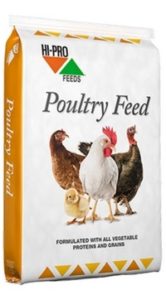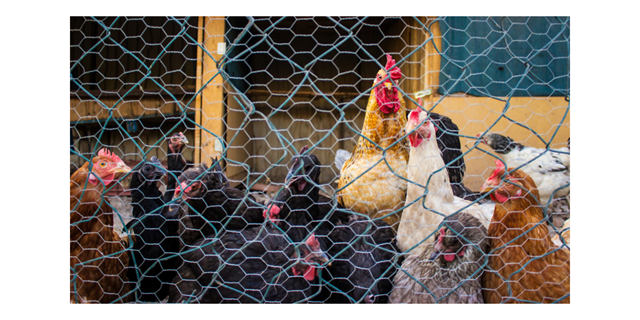In this article, we go over the steps required for raising backyard chickens. To download our full Backyard Poultry Guide, click here.
Buying Chickens
The number of birds you raise will depend primarily on the amount of space that you have available.
Bird Types
You can choose between non-selected or traditional breeds, and selected or modern breeds. Modern breeds have been selected based on meat production and carcass traits (meat-type) or on egg production (egg-type). Modern breeds, or strains, are often called by the name of the breeding company. Ross and Cobb are meat-type birds that will convert feed to meat very efficiently. However, they are very poor egg layers. Lohmann and Hy-Line are egg-type birds that will convert feed to eggs very efficiently, but have extremely poor carcass traits. If you want to purchase modern, selected breeds you will likely need to contact a commercial hatchery.
If you choose a traditional breed, you have the choice of single purpose or dual purpose breeds. Dual purpose breeds (Barred Plymouth Rock, Rhode Island Red, and New Hampshire) can be used for eggs and meat. The cockerel can be raised for meat and the pullets will lay a good quantity of brown eggs.
Most modern meat-type birds are based on the White Rock or Cornish breeds and either of these traditional breeds will produce good quantities of meat. These pullets can be used for brown egg production provided you don’t allow them to exceed 5.5 lb (2.5 kg) in body weight at the time of first egg. Modern egg-type chickens are based on the White Leghorn because the White Leghorn is a very efficient egg producer. White Leghorn’s lay large, high quality, white eggs. For brown eggs, choose a coloured chicken such as the Rhode Island Red. There are also several strains of modern brown egg layers available through your commercial hatchery.
Housing
When possible, the poultry house should be away from other livestock buildings. Windows should face the east to prevent over-heating on warm sunny days. The house should be well insulated, free from drafts, and have a solid floor of either cement or wood.
Before the birds arrive, clean out the old litter and droppings and wash the inside of the house. When the walls and ceiling are dry, wipe or spray them with a good disinfectant. Feeders and waterers should also be washed and disinfected prior to use. Proper disinfection is particularly important if disease was a problem with the previous flock.
Brooder
Day old chicks should be started in a warm, dry, and draft-free area. Place a brooder guard, such as a cardboard ring, around the heat source to confine the birds to the
heat, water and feed. The brooder diameter should start at 2 – 3 ft (60 – 90 cm) larger than the heat source and should increase as the birds grow. At 7 – 10 days, remove
the brooder ring and place the feeders and waterers around the house.
Water
Fill the waterers several hours before the birds arrive so that the water is at room temperature. Put in extra water for the first few days. As each bird is placed in the brooder, dip its beak in the water so they get a drink and learn to find water. Provide fresh water daily.
Temperature
The heat source should be at least 16 in (40 cm) above the litter to minimize fire hazard. More than one heat lamp is recommended in case a bulb burns out. Set the temperature at 90 – 95°F (32 – 35°C) for day old chicks, and decrease the temperature 5°F (3°C) each week thereafter. Check the temperature at chick level and observe the chicks’ comfort level. If the chicks pant or press against the edges of the brooder, they are too hot; if they huddle together in a pile, they are too cold. Sharp chirping indicates discomfort. Adjust the heat source as necessary.
Lighting
Chicks should have continuous light for the first 3 – 7 days to ensure they find the feed and water. After 1 week, they should have 12 hours of continuous light per day. (see specific lighting requirements for each type of poultry). Use 60 watt incandescent bulbs for the first 2 weeks then use 20 watt bulbs. Reduced light intensity will help reduce cannibalism.
If the chicken coop has electricity, light bulbs will help to keep it warm in winter and prevent drinking water from freezing. Lighting can also be used to stimulate laying during the winter. Giving the chickens light during the evening or early morning to simulate 14 – 16 hours of sunlight will increase winter production. Automatic timing devices to turn the lights on and off are available and recommended.
Broiler chicks should be provided light 23 – 24 hours a day for the first 3 days, with an intensity of approximately 20 lux. For the next 3 weeks, the light can be reduced to 8 – 14 hours/day and the intensity can be reduced to about 10 lux. This will slow early growth and help to prevent leg problems and heart complications later. At 3 weeks of age, you may want to return to 24 hours of light to encourage maximum growth or stay on the lighting program allowing periods of darkness.
Laying hens normally lay between early spring and mid-fall. Increasing day length (January – June) stimulates egg production; decreasing day length (July – December) inhibits egg production. Start chicks at 24 hours of light for 3 – 7 days. After the chicks have found feed and water, reduce the light to 16 hours. Up to 3 weeks of age, gradually decrease the light to 10 hours per day. Maintain 10 hours of light until the pullets are large enough to start to lay eggs (usually 18 – 20 weeks), and then begin to increase the day length. Increase the light 30 minutes each week until there is 16 hours of light.
 Feed
Feed
Place feed in the feeders and on low flat trays that are easy for the chicks to reach (egg cartons work well) or use commercial chick paper if available. Remove the trays once the birds have learned to eat from the feeders. Commercial chick paper will disintegrate and disappear as the birds age. Chicks will require 1 in (2 – 3 cm) of feeder space per bird.
Feed should be available at all times. Chicks should be started on a high protein ration. Poultry starter should be fed free choice up to 3 weeks of age.
Broiler rations should be fed free choice. Feeding a complete ration will produce healthier birds that are less susceptible to disease. Birds fed whole grain diets only,
may develop leg problems due to low vitamin and mineral levels.
In order to maximize egg production, laying hens should be fed laying rations free choice. Laying pellets fed alone provide a complete diet with a sufficient amount of calcium. Laying hens need calcium to keep the shells thick. If laying pellets are combined with other whole grains, the levels of vitamins and minerals, including calcium, will be diluted. Oyster shell can be offered free choice or sprinkled over the feed for additional calcium.
Check out our poultry products here.
Hen/Chick Scratch
Feeding various whole grains with cracked corn is called hen/chick scratch. It is not an adequately balanced diet because it contains no vitamins or minerals. Birds may develop nutritional deficiencies if scratch is fed alone. Scratch can be used as a treat and to keep the litter loose.
Litter
Chicks should be raised on a clean, dry, absorbent material such as wood shavings or sawdust. Straw and shredded paper will also work but are more difficult to maintain. Leg problems may develop if the birds are placed on slippery material such as paper. The litter should be 3 – 4 in (7 – 10 cm) deep in the brooding area. Stir the litter daily to keep it dry; replace the litter if it gets wet or cakes. Wet litter is a major source of disease.
Nesting Boxes for Laying Hens
Provide one nest box 12 x 12 x 12 in (30 x 30 x 30 cm) for every four hens. A temperature range between 45 – 80°F (7 – 27°C) is acceptable. In extremely cold weather, supplemental heat may be needed.
Laying Hen Tips
When will my chickens lay?
Pullets hatched very early in the spring may start laying in the fall, but won’t reach peak production until the following spring. Hens are at their peak production from 1 – 2 years of age. A 4 – 5 year old chicken is “old”.
Why are my hens not laying?
Hens may stop laying for various reasons. A change in location, feed, or severe temperature fluctuations may cause temporary changes to the laying pattern. If the chickens are receiving fortified laying pellets as their sole ration, their nutritional requirements for egg production will be met. However, if other grains are also being fed, the hens may be deficient in protein which will reduce egg production. Other causes may be an inadequate water supply, parasites, or disease.
Moulting
Moulting is the shedding and re-growth of feathers. It occurs once a year, usually in the autumn, and lasts 6 – 8 weeks. Egg production generally stops during a moult. Major disturbances such as very cold weather, decreasing day length, lack of feed or water can cause a moult. It occurs naturally in hens after 1 year of laying.
How do I tell if a hen is laying?
Laying hens have large, bright red combs; soft, deep abdomens; large moist vents; and a 3 – 4 finger space between the pubic bones (just in front of the vent on the underside of the chicken are two pointed pubic bones). The beaks and shanks will be light in colour. Non-layers have shrunken, dull combs and about 1 – 2 finger space
between the pubic bones. The beaks and shanks will be yellow-coloured.
Vaccination
Chicks are very susceptible to a disease called coccidiosis which causes severe digestive disorders. Mortality can approach 90% if the chicks are not fed a medicated feed, or are not vaccinated to help prevent coccidiosis at the hatchery. Check with the hatchery to find out what vaccinations were given.
For a coccidiosis vaccination to adequately provide immunity to the growing birds, adequate spray techniques at the hatchery and careful management of the growing birds is
required to help develop immunity.
Providing medicated feed (medicated for coccidiosis control) to coccidiosis vaccinated chicks will disrupt the vaccination process. If vaccinated birds are given medicated feed to control coccidiosis, continue feeding until birds have reached an age where immunity is likely to have developed (typically more than 6 weeks of age).
Interested in our poultry products? Click here.


